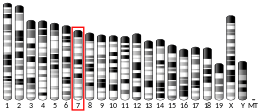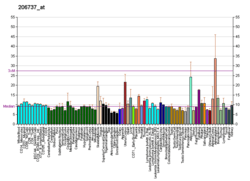WNT11
Protein Wnt-11 is a protein that in humans is encoded by the WNT11 gene.[5][6]
The WNT gene family consists of structurally related genes that encode secreted signaling proteins. These proteins have been implicated in oncogenesis and in several developmental processes, including regulation of cell fate and patterning during embryogenesis. This gene is a member of the WNT gene family. It encodes a protein showing 97%, 85%, and 63% amino acid identity with mouse, chicken, and Xenopus Wnt11 protein, respectively. This gene may play roles in the development of skeleton, kidney, and lung, and is considered to be a plausible candidate gene for High Bone Mass Syndrome.[6]
References
- GRCh38: Ensembl release 89: ENSG00000085741 - Ensembl, May 2017
- GRCm38: Ensembl release 89: ENSMUSG00000015957 - Ensembl, May 2017
- "Human PubMed Reference:". National Center for Biotechnology Information, U.S. National Library of Medicine.
- "Mouse PubMed Reference:". National Center for Biotechnology Information, U.S. National Library of Medicine.
- Lako M, Strachan T, Bullen P, Wilson DI, Robson SC, Lindsay S (Dec 1998). "Isolation, characterisation and embryonic expression of WNT11, a gene which maps to 11q13.5 and has possible roles in the development of skeleton, kidney and lung". Gene. 219 (1–2): 101–10. doi:10.1016/S0378-1119(98)00393-X. PMID 9757009.
- "Entrez Gene: WNT11 wingless-type MMTV integration site family, member 11".
Further reading
- Smolich BD, McMahon JA, McMahon AP, Papkoff J (1994). "Wnt family proteins are secreted and associated with the cell surface". Mol. Biol. Cell. 4 (12): 1267–75. doi:10.1091/mbc.4.12.1267. PMC 275763. PMID 8167409.
- Kirikoshi H, Sekihara H, Katoh M (2002). "Molecular cloning and characterization of human WNT11". Int. J. Mol. Med. 8 (6): 651–6. doi:10.3892/ijmm.8.6.651. PMID 11712081.
- Strausberg RL; Feingold EA; Grouse LH; et al. (2003). "Generation and initial analysis of more than 15,000 full-length human and mouse cDNA sequences". Proc. Natl. Acad. Sci. U.S.A. 99 (26): 16899–903. doi:10.1073/pnas.242603899. PMC 139241. PMID 12477932.
- Ouko L; Ziegler TR; Gu LH; et al. (2004). "Wnt11 signaling promotes proliferation, transformation, and migration of IEC6 intestinal epithelial cells". J. Biol. Chem. 279 (25): 26707–15. doi:10.1074/jbc.M402877200. PMC 1351009. PMID 15084607.
- Gerhard DS; Wagner L; Feingold EA; et al. (2004). "The status, quality, and expansion of the NIH full-length cDNA project: the Mammalian Gene Collection (MGC)". Genome Res. 14 (10B): 2121–7. doi:10.1101/gr.2596504. PMC 528928. PMID 15489334.
- Kim SW; Park JI; Spring CM; et al. (2005). "Non-canonical Wnt signals are modulated by the Kaiso transcriptional repressor and p120-catenin". Nat. Cell Biol. 6 (12): 1212–20. doi:10.1038/ncb1191. PMID 15543138.
- Koyanagi M; Haendeler J; Badorff C; et al. (2005). "Non-canonical Wnt signaling enhances differentiation of human circulating progenitor cells to cardiomyogenic cells". J. Biol. Chem. 280 (17): 16838–42. doi:10.1074/jbc.M500323200. PMID 15701629.
- Garriock RJ, D'Agostino SL, Pilcher KC, Krieg PA (2005). "Wnt11-R, a protein closely related to mammalian Wnt11, is required for heart morphogenesis in Xenopus". Dev. Biol. 279 (1): 179–92. doi:10.1016/j.ydbio.2004.12.013. PMID 15708567.
- Otsuki T; Ota T; Nishikawa T; et al. (2007). "Signal sequence and keyword trap in silico for selection of full-length human cDNAs encoding secretion or membrane proteins from oligo-capped cDNA libraries". DNA Res. 12 (2): 117–26. doi:10.1093/dnares/12.2.117. PMID 16303743.
- Panáková D, Werdich AA, Macrae CA (2010). "Wnt11 patterns a myocardial electrical gradient through regulation of the L-type Ca(2+) channel". Nature. 466 (8): 874–878. doi:10.1038/nature09249. PMC 2921013. PMID 20657579.
This article is issued from Wikipedia. The text is licensed under Creative Commons - Attribution - Sharealike. Additional terms may apply for the media files.




